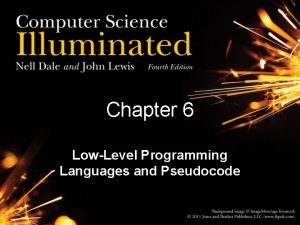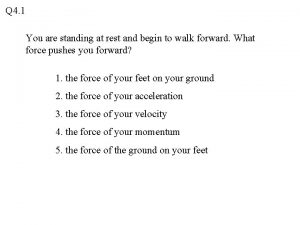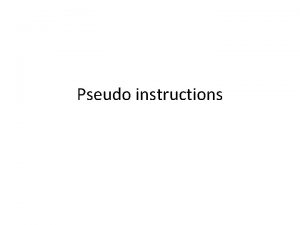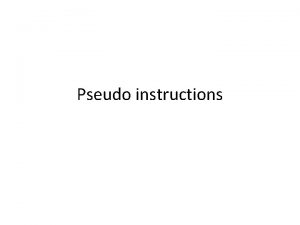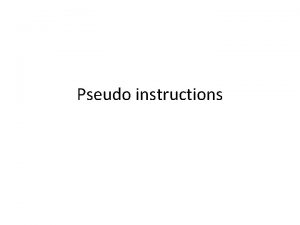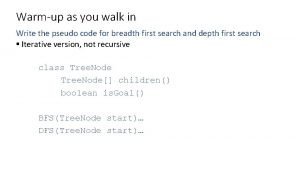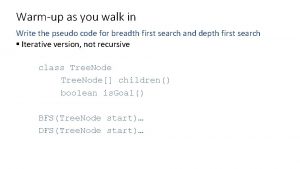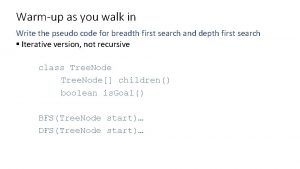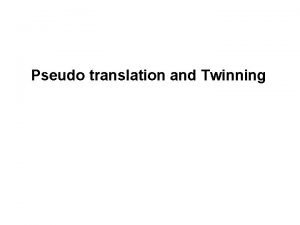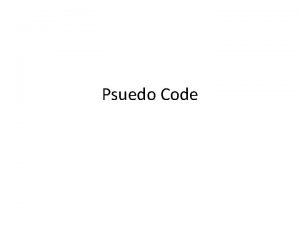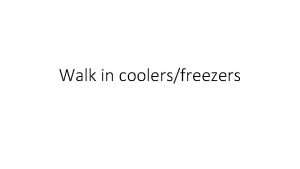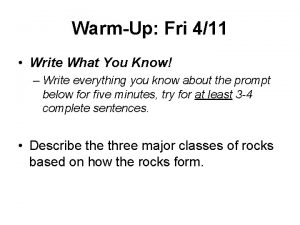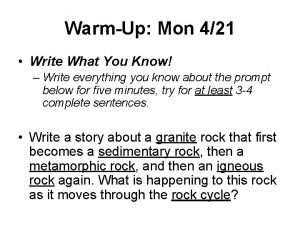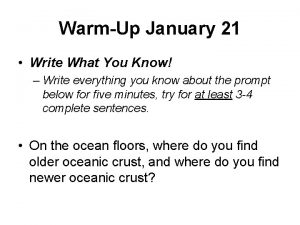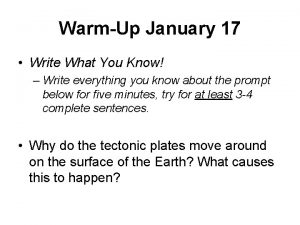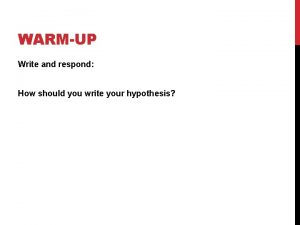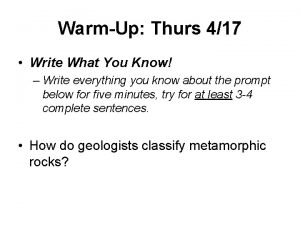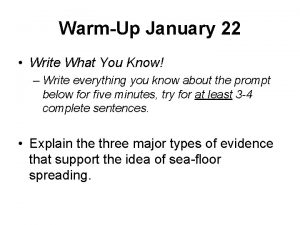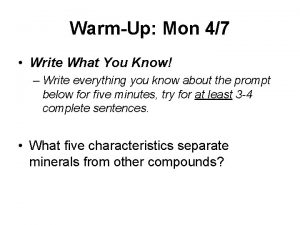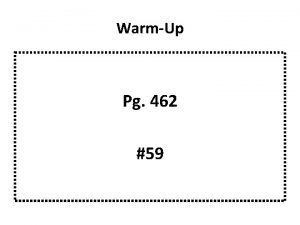Warmup as you walk in Write the pseudo











![Demo Reflex Agent [Demo: reflex optimal (L 2 D 1)] [Demo: reflex optimal (L Demo Reflex Agent [Demo: reflex optimal (L 2 D 1)] [Demo: reflex optimal (L](https://slidetodoc.com/presentation_image_h/1f9bb93e8014b67267d7fb08fa738123/image-12.jpg)











































- Slides: 55

Warm-up as you walk in Write the pseudo code for breadth first search and depth first search § Iterative version, not recursive class Tree. Node[] children() boolean is. Goal() BFS(Tree. Node start)… DFS(Tree. Node start)…

Announcements If you are not on Piazza, Gradescope, and Canvas § E-mail us: feifang@cmu. edu, pvirtue@cmu. edu Recitation starting this Friday § Choose your section; priority based on registered section § Bring laptop if you can (not required) § Start P 0 before recitation to make sure Python 3. 6 is working for you! In-class Piazza Polls

Announcements Assignments: § HW 1 (online) § Due Tue 9/3, 10 pm § P 0: Python & Autograder Tutorial § Due Thu 9/5, 10 pm § No pairs, submit individually § P 1: Search and Games § Released after lecture § Due Thu 9/12, 10 pm § May be done in pairs Remaining programming assignments may be done in pairs

AI: Representation and Problem Solving Agents and Search Instructors: Pat Virtue & Fei Fang Slide credits: CMU AI, http: //ai. berkeley. edu

Today Agents and Environment Search Problems Uninformed Search Methods § Depth-First Search § Breadth-First Search § Uniform-Cost Search

Rationality, contd. What is rational depends on: § Performance measure § Agent’s prior knowledge of environment § Actions available to agent § Percept sequence to date Being rational means maximizing your expected utility

Rational Agents Are rational agents omniscient? § No – they are limited by the available percepts Are rational agents clairvoyant? § No – they may lack knowledge of the environment dynamics Do rational agents explore and learn? § Yes – in unknown environments these are essential So rational agents are not necessarily successful, but they are autonomous (i. e. , transcend initial program)

Task Environment - PEAS Performance measure § -1 per step; +10 food; +500 win; -500 die; +200 hit scared ghost Environment § Pacman dynamics (incl ghost behavior) Actuators § North, South, East, West, (Stop) Sensors § Entire state is visible

PEAS: Automated Taxi Performance measure § Income, happy customer, vehicle costs, fines, insurance premiums Environment § US streets, other drivers, customers Actuators § Steering, brake, gas, display/speaker Sensors § Camera, radar, accelerometer, engine sensors, microphone Image: http: //nypost. com/2014/06/21/how-google-might-put-taxi-drivers-out-of-business/

Environment Types Pacman Fully or partially observable Single agent or multi-agent Deterministic or stochastic Static or dynamic Discrete or continuous Taxi

Reflex Agents Reflex agents: § Choose action based on current percept (and maybe memory) § May have memory or a model of the world’s current state § Do not consider the future consequences of their actions § Consider how the world IS Can a reflex agent be rational? [Demo: reflex optimal (L 2 D 1)] [Demo: reflex optimal (L 2 D 2)]
![Demo Reflex Agent Demo reflex optimal L 2 D 1 Demo reflex optimal L Demo Reflex Agent [Demo: reflex optimal (L 2 D 1)] [Demo: reflex optimal (L](https://slidetodoc.com/presentation_image_h/1f9bb93e8014b67267d7fb08fa738123/image-12.jpg)
Demo Reflex Agent [Demo: reflex optimal (L 2 D 1)] [Demo: reflex optimal (L 2 D 2)]

Agents that Plan Ahead Planning agents: § Decisions based on predicted consequences of actions § Must have a transition model: how the world evolves in response to actions § Must formulate a goal § Consider how the world WOULD BE Spectrum of deliberativeness: § Generate complete, optimal plan offline, then execute § Generate a simple, greedy plan, start executing, replan when something goes wrong

Search Problems

Search Problems A search problem consists of: § A state space § For each state, a set Actions(s) of allowable actions § A transition model Result(s, a) {N, E} N E 1 1 § A step cost function c(s, a, s’) § A start state and a goal test A solution is a sequence of actions (a plan) which transforms the start state to a goal state

Search Problems Are Models

Example: Travelling in Romania State space: § Cities Actions: § Go to adjacent city Transition model § Result(A, Go(B)) = B Step cost § Distance along road link Start state: § Arad Goal test: § Is state == Bucharest? Solution?

What’s in a State Space? The real world state includes every last detail of the environment A search state abstracts away details not needed to solve the problem • Problem: Pathing • • State representation: (x, y) location Actions: NSEW Transition model: update location Goal test: is (x, y)=END • Problem: Eat-All-Dots • State representation: {(x, y), dot booleans} • Actions: NSEW • Transition model: update location and possibly a dot boolean • Goal test: dots all false

State Space Sizes? World state: § Agent positions: 120 § Food count: 30 § Ghost positions: 12 § Agent facing: NSEW How many § World states? 120 x(230)x(122)x 4 § States for pathing? 120 § States for eat-all-dots? 120 x(230)

Safe Passage Problem: eat all dots while keeping the ghosts perma-scared What does the state representation have to specify? § (agent position, dot booleans, power pellet booleans, remaining scared time)

State Space Graphs and Search Trees

State Space Graphs State space graph: A mathematical representation of a search problem § Nodes are (abstracted) world configurations § Arcs represent transitions resulting from actions § The goal test is a set of goal nodes (maybe only one) In a state space graph, each state occurs only once! We can rarely build this full graph in memory (it’s too big), but it’s a useful idea

More Examples

More Examples

State Space Graphs vs. Search Trees Consider this 4 -state graph: How big is its search tree (from S)? S a G S b a b b G G a b G ∞ Important: Lots of repeated structure in the search tree!

Tree Search vs Graph Search

function TREE_SEARCH(problem) returns a solution, or failure initialize the frontier as a specific work list (stack, queue, priority queue) add initial state of problem to frontier loop do if the frontier is empty then return failure choose a node and remove it from the frontier if the node contains a goal state then return the corresponding solution for each resulting child from node add child to the frontier

function GRAPH_SEARCH(problem) returns a solution, or failure initialize the explored set to be empty initialize the frontier as a specific work list (stack, queue, priority queue) add initial state of problem to frontier loop do if the frontier is empty then return failure choose a node and remove it from the frontier if the node contains a goal state then return the corresponding solution add the node state to the explored set for each resulting child from node if the child state is not already in the frontier or explored set then add child to the frontier

Piazza Poll 1 What is the relationship between these sets of states after each loop iteration in GRAPH_SEARCH? (Loop invariants!!!) A Explored Never Seen Frontier B Explored Frontier Never Seen C Explored Frontier Never Seen

Piazza Poll 1 What is the relationship between these sets of states after each loop iteration in GRAPH_SEARCH? (Loop invariants!!!) A Explored Never Seen Frontier B Explored Frontier Never Seen C Explored Frontier Never Seen

Piazza Poll 1 function GRAPH-SEARCH(problem) returns a solution, or failure initialize the explored set to be empty initialize the frontier as a specific work list (stack, queue, priority queue) add initial state of problem to frontier loop do if the frontier is empty then return failure choose a node and remove it from the frontier if the node contains a goal state then return the corresponding solution add the node state to the explored set for each resulting child from node if the child state is not already in the frontier or explored set then add child to the frontier

Graph Search This graph search algorithm overlays a tree on a graph The frontier states separate the explored states from never seen states Images: AIMA, Figure 3. 8, 3. 9

BFS vs DFS

Piazza Poll 2 Is the following demo using BFS or DFS [Demo: dfs/bfs maze water (L 2 D 6)]

A Note on Implementation Nodes have state, parent, action, path-cost A child of node by action a has state = result(node. state, a) parent = node action = a path-cost = node. path_cost + step_cost(node. state, a, self. state) Extract solution by tracing back parent pointers, collecting actions

Walk-through DFS Graph Search G a c b e d S f h p q r

BFS vs DFS When will BFS outperform DFS? When will DFS outperform BFS?

Search Algorithm Properties

Search Algorithm Properties Complete: Guaranteed to find a solution if one exists? Optimal: Guaranteed to find the least cost path? Time complexity? Space complexity? Cartoon of search tree: § b is the branching factor § m is the maximum depth § solutions at various depths Number of nodes in entire tree? § 1 + b 2 + …. bm = O(bm) … b 1 node b nodes b 2 nodes m tiers bm nodes

Search Algorithm Properties Complete: Guaranteed to find a solution if one exists? Optimal: Guaranteed to find the least cost path? Time complexity? Space complexity? Cartoon of search tree: § b is the branching factor § m is the maximum depth § solutions at various depths Number of nodes in entire tree? § 1 + b 2 + …. bm = O(bm) … b 1 node b nodes b 2 nodes m tiers bm nodes

Piazza Poll 3 Are these the properties for BFS or DFS? § Takes O(bm) time m tiers § Uses O(bm) space on frontier § Complete with graph search § Not optimal unless all goals are in the same level (and the same step cost everywhere) … b 1 node b nodes b 2 nodes bm nodes

Depth-First Search (DFS) Properties What nodes does DFS expand? § Some left prefix of the tree. § Could process the whole tree! § If m is finite, takes time O(bm) How much space does the frontier take? … m tiers b 1 node b nodes b 2 nodes § Only has siblings on path to root, so O(bm) Is it complete? § m could be infinite, so only if we prevent cycles (graph search) Is it optimal? § No, it finds the “leftmost” solution, regardless of depth or cost bm nodes

Breadth-First Search (BFS) Properties What nodes does BFS expand? § Processes all nodes above shallowest solution § Let depth of shallowest solution be s § Search takes time O(bs) How much space does the frontier take? § Has roughly the last tier, so O(bs) Is it complete? § s must be finite if a solution exists, so yes! Is it optimal? § Only if costs are all the same (more on costs later) s tiers … b 1 node b nodes b 2 nodes bs nodes bm nodes

Iterative Deepening Idea: get DFS’s space advantage with BFS’s time / shallow-solution advantages § Run a DFS with depth limit 1. If no solution… § Run a DFS with depth limit 2. If no solution… § Run a DFS with depth limit 3. …. . Isn’t that wastefully redundant? § Generally most work happens in the lowest level searched, so not so bad! … b

Finding a Least-Cost Path a 2 GOAL 2 c b 1 3 2 d 3 START e 9 8 p 15 f 2 h 4 1 2 8 4 q 2 r

Depth-First (Tree) Search Strategy: expand a deepest node first G a c b Implementation: Frontier is a LIFO stack e d S f h p r q S e d b c a a h e h p q q c a r p f q G p q r q f c a G

Breadth-First (Tree) Search Strategy: expand a shallowest node first a b Implementation: Frontier is a FIFO queue G c e d S f h p r q S e d Search Tiers b c a a e h p q q c a h r p f q G p q r q f c a G

Uniform Cost (Tree) Search 2 Strategy: expand a cheapest node first: b d S 1 p c 8 1 3 Frontier is a priority queue (priority: cumulative cost) G a 15 2 e 9 r Cost contours c a 6 a 11 p 9 e h 17 r 11 e 5 h 13 r 7 p f 8 q q q 11 c a G 10 1 0 3 b 4 f 2 q S d 8 h 2 q f c a G p 1 q 16

Uniform Cost Search

function GRAPH_SEARCH(problem) returns a solution, or failure initialize the explored set to be empty initialize the frontier as a specific work list (stack, queue, priority queue) add initial state of problem to frontier loop do if the frontier is empty then return failure choose a node and remove it from the frontier if the node contains a goal state then return the corresponding solution add the node state to the explored set for each resulting child from node if the child state is not already in the frontier or explored set then add child to the frontier

function UNIFORM-COST-SEARCH(problem) returns a solution, or failure initialize the explored set to be empty initialize the frontier as a priority queue using node path_cost as the priority add initial state of problem to frontier with path_cost = 0 2 C loop do A if the frontier is empty then 1 return failure B S 4 choose a node and remove it from the frontier if the node contains a goal state then return the corresponding solution add the node state to the explored set for each resulting child from node if the child state is not already in the frontier or explored set then add child to the frontier else if the child is already in the frontier with higher path_cost then replace that frontier node with child G 4 1 D 3

Walk-through UCS 2 C G 4 A 1 S 4 B 1 D 3

Walk-through UCS a 2 GOAL 2 c b 1 3 8 d START 2 p 9 15 q 2 e h 4 1 3 4 8 f 2 2 r

Uniform Cost Search (UCS) Properties What nodes does UCS expand? § Processes all nodes with cost less than cheapest solution! § If that solution costs C* and arcs cost at least , then the “effective depth” is roughly C*/ § Takes time O(b. C*/ ) (exponential in effective depth) How much space does the frontier take? § Has roughly the last tier, so O(b. C*/ ) b C*/ “tiers” Is it complete? § Assuming best solution has a finite cost and minimum arc cost is positive, yes! Is it optimal? § Yes! (Proof next lecture via A*) … c 1 c 2 c 3

Uniform Cost Issues Remember: § UCS explores increasing cost contours … The good: § UCS is complete and optimal! The bad: § Explores options in every “direction” § No information about goal location We’ll fix that soon! Start c 1 c 2 c 3 Goal
 Warmup ratio
Warmup ratio Warmup 65
Warmup 65 Gmass warmup
Gmass warmup Stratified warmup
Stratified warmup Surface area warm up
Surface area warm up Rhyme glow
Rhyme glow Product of powers
Product of powers Java warmup
Java warmup Define:warmup
Define:warmup Pathos story
Pathos story Tinman running calculator
Tinman running calculator Warmup 65
Warmup 65 Warmup end
Warmup end How to read pseudocode
How to read pseudocode You are standing at rest and begin to walk forward
You are standing at rest and begin to walk forward Hát kết hợp bộ gõ cơ thể
Hát kết hợp bộ gõ cơ thể Lp html
Lp html Bổ thể
Bổ thể Tỉ lệ cơ thể trẻ em
Tỉ lệ cơ thể trẻ em Gấu đi như thế nào
Gấu đi như thế nào Thang điểm glasgow
Thang điểm glasgow Bài hát chúa yêu trần thế alleluia
Bài hát chúa yêu trần thế alleluia Kể tên các môn thể thao
Kể tên các môn thể thao Thế nào là hệ số cao nhất
Thế nào là hệ số cao nhất Các châu lục và đại dương trên thế giới
Các châu lục và đại dương trên thế giới Công thức tính độ biến thiên đông lượng
Công thức tính độ biến thiên đông lượng Trời xanh đây là của chúng ta thể thơ
Trời xanh đây là của chúng ta thể thơ Cách giải mật thư tọa độ
Cách giải mật thư tọa độ 101012 bằng
101012 bằng độ dài liên kết
độ dài liên kết Các châu lục và đại dương trên thế giới
Các châu lục và đại dương trên thế giới Thể thơ truyền thống
Thể thơ truyền thống Quá trình desamine hóa có thể tạo ra
Quá trình desamine hóa có thể tạo ra Một số thể thơ truyền thống
Một số thể thơ truyền thống Cái miệng xinh xinh thế chỉ nói điều hay thôi
Cái miệng xinh xinh thế chỉ nói điều hay thôi Vẽ hình chiếu vuông góc của vật thể sau
Vẽ hình chiếu vuông góc của vật thể sau Biện pháp chống mỏi cơ
Biện pháp chống mỏi cơ đặc điểm cơ thể của người tối cổ
đặc điểm cơ thể của người tối cổ V cc cc
V cc cc Vẽ hình chiếu đứng bằng cạnh của vật thể
Vẽ hình chiếu đứng bằng cạnh của vật thể Vẽ hình chiếu vuông góc của vật thể sau
Vẽ hình chiếu vuông góc của vật thể sau Thẻ vin
Thẻ vin đại từ thay thế
đại từ thay thế điện thế nghỉ
điện thế nghỉ Tư thế ngồi viết
Tư thế ngồi viết Diễn thế sinh thái là
Diễn thế sinh thái là Dạng đột biến một nhiễm là
Dạng đột biến một nhiễm là Các số nguyên tố là gì
Các số nguyên tố là gì Tư thế ngồi viết
Tư thế ngồi viết Lời thề hippocrates
Lời thề hippocrates Thiếu nhi thế giới liên hoan
Thiếu nhi thế giới liên hoan ưu thế lai là gì
ưu thế lai là gì Sự nuôi và dạy con của hươu
Sự nuôi và dạy con của hươu Sự nuôi và dạy con của hươu
Sự nuôi và dạy con của hươu Hệ hô hấp
Hệ hô hấp Từ ngữ thể hiện lòng nhân hậu
Từ ngữ thể hiện lòng nhân hậu













